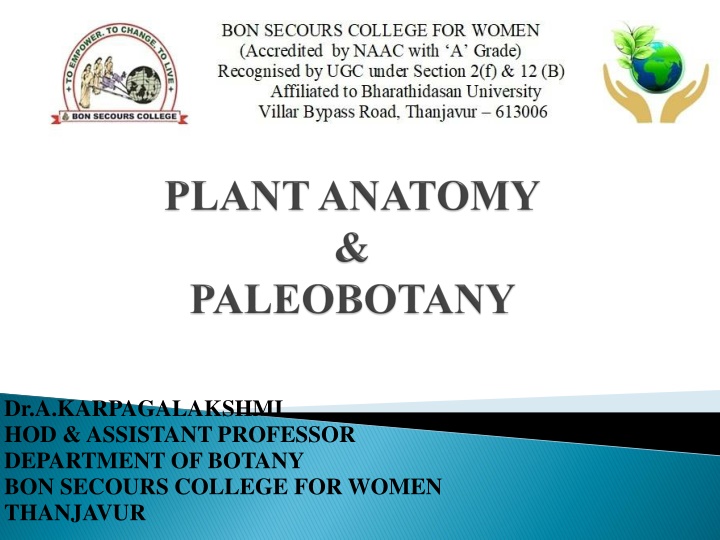
Plant Biology Insights: Tissues, Photosynthesis, and More
Delve into the fascinating world of plant biology with Dr. A. Karpagalakshmi, exploring topics such as plant anatomy, photosynthesis, respiration, and different types of tissues. Discover the intricate structures and processes within plants, including simple and complex tissues, meristematic cells, and the functions of various plant parts. Enhance your knowledge of plant science and appreciate the beauty of the living world of plants.
Download Presentation

Please find below an Image/Link to download the presentation.
The content on the website is provided AS IS for your information and personal use only. It may not be sold, licensed, or shared on other websites without obtaining consent from the author. If you encounter any issues during the download, it is possible that the publisher has removed the file from their server.
You are allowed to download the files provided on this website for personal or commercial use, subject to the condition that they are used lawfully. All files are the property of their respective owners.
The content on the website is provided AS IS for your information and personal use only. It may not be sold, licensed, or shared on other websites without obtaining consent from the author.
E N D
Presentation Transcript
Dr.A.KARPAGALAKSHMI HOD & ASSISTANT PROFESSOR DEPARTMENT OF BOTANY BON SECOURS COLLEGE FOR WOMEN THANJAVUR
Living world of Plants Plant anatomy Photosynthesis Respiration Monocot& Dicot Stem, Root,Leaves chloroplast light dependant & independent reaction Str.of Mitochondria Glycolysis,Krebs Cycle,Etc
Tissues groups of similer (or) disimilar cells having common origin and performing similar functions. Types: simple & complex Simple tissues : the tissues composed of single types of cells Types; parenchyma, collenchyma, sclerenchyma
Plant Tissues Meristematic Permanent Apical Meristem Intercalary Meristem Lateral Meristem
SIMPLE TISSUES COMPLEX TISSUES Only one type of cell Different type of cells Occur in all part of plant Occur in vascular region Variety of the function Perform mainly conduction Parenchyma, collenchyma& sclerenchyma Xylem, phloem




